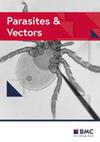针对不同 DNA 区域的多平行定量实时 PCR 与检测粪便中土壤传播蠕虫的比较
IF 3
2区 医学
Q1 PARASITOLOGY
引用次数: 0
摘要
据估计,土壤传播的蠕虫感染了全球 18% 的人口,造成了巨大的健康负担。显微镜一直是诊断粪便样本中虫卵的主要工具,但在低发病率环境下,其灵敏度会下降。实时定量聚合酶链反应(qPCR)在研究和临床中的应用正在缓慢增加。然而,人们对首选的 qPCR 目标仍未达成共识。我们的目的是通过检测添加了已知数量 STH 虫卵和幼虫的天真粪便样本,比较土壤传播蠕虫(STH)DNA 检测方法。针对核糖体或假定的非蛋白编码卫星序列,我们使用独立的定量实时 PCR(qPCR)检测方法对加标样本的 DNA 提取物进行了检测。对于毛滴虫,使用任一种 qPCR 方法检测的虫卵/幼虫计数与 qPCR 结果之间都有很强的相关性(分别为 0.86 和 0.87)。疟原虫的相关性也很强(分别为 0.60 和 0.63),但十二指肠疟(两种检测方法的相关性均为 0.41)和盘尾丝虫病(分别为 0.48 和 0.65)的相关性较弱。在使用两种 qPCR 检测方法进行检测时,均未观察到与美洲鼻疽的相关性。在使用现场采集的粪便样本时,这两种检测方法在不同目标上都有相当到中等程度的一致性(0.28-0.45,适用于所有 STHs),只有盘尾丝虫(0.12)略有一致性。qPCR 结果与虫卵/幼虫计数之间有很强的相关性。我们的研究证实,无论使用哪种基于 DNA 的诊断标记,qPCR 都是一种有效的诊断工具,即使是低强度感染。不过,在检测现场样本时,两种不同的 qPCR 检测方法之间的一致性一般,这突出表明有必要了解这些靶标在基因组中的作用,以便通过 qPCR 更准确、更一致地量化寄生虫负担。本文章由计算机程序翻译,如有差异,请以英文原文为准。
Comparison of multi-parallel quantitative real-time PCRs targeting different DNA regions and detecting soil-transmitted helminths in stool
Soil-transmitted helminths infect an estimated 18% of the world’s population, causing a significant health burden. Microscopy has been the primary tool for diagnosing eggs from fecal samples, but its sensitivity drops in low-prevalence settings. Quantitative real-time polymerase chain reaction (qPCR) is slowly increasing in research and clinical settings. However, there is still no consensus on preferred qPCR targets. We aimed to compare soil-transmitted helminth (STH) DNA detection methods by testing naïve stool samples spiked with known quantities of STH eggs and larvae. DNA extracts from spiked samples were tested using independent quantitative realtime PCR (qPCR) assays targeting ribosomal or putative non-protein coding satellite sequences. For Trichuris trichiura, there was a strong correlation between egg/larvae counts and qPCR results using either qPCR method (0.86 and 0.87, respectively). Strong correlations also existed for A. lumbricoides (0.60 and 0.63, respectively), but weaker correlations were found for Ancylostoma duodenale (0.41 for both assays) and Strongyloides stercoralis (0.48 and 0.65, respectively). No correlation for Necator americanus was observed when testing with either qPCR assay. Both assays had fair-to-moderate agreement across targets when using field-collected stool samples (0.28–0.45, for all STHs), except for S. stercoralis (0.12) with slight agreement. There is a strong correlation between qPCR results and egg/larvae counts. Our study confirms that qPCR is an effective diagnostic tool, even with low-intensity infections, regardless of the DNA-based diagnostic marker used. However, the moderate agreement between the two different qPCR assays when testing field samples highlights the need to understand the role of these targets in the genome so that the parasite burden can be quantified more accurately and consistently by qPCR.
求助全文
通过发布文献求助,成功后即可免费获取论文全文。
去求助
来源期刊

Parasites & Vectors
医学-寄生虫学
CiteScore
6.30
自引率
9.40%
发文量
433
审稿时长
1.4 months
期刊介绍:
Parasites & Vectors is an open access, peer-reviewed online journal dealing with the biology of parasites, parasitic diseases, intermediate hosts, vectors and vector-borne pathogens. Manuscripts published in this journal will be available to all worldwide, with no barriers to access, immediately following acceptance. However, authors retain the copyright of their material and may use it, or distribute it, as they wish.
Manuscripts on all aspects of the basic and applied biology of parasites, intermediate hosts, vectors and vector-borne pathogens will be considered. In addition to the traditional and well-established areas of science in these fields, we also aim to provide a vehicle for publication of the rapidly developing resources and technology in parasite, intermediate host and vector genomics and their impacts on biological research. We are able to publish large datasets and extensive results, frequently associated with genomic and post-genomic technologies, which are not readily accommodated in traditional journals. Manuscripts addressing broader issues, for example economics, social sciences and global climate change in relation to parasites, vectors and disease control, are also welcomed.
 求助内容:
求助内容: 应助结果提醒方式:
应助结果提醒方式:


